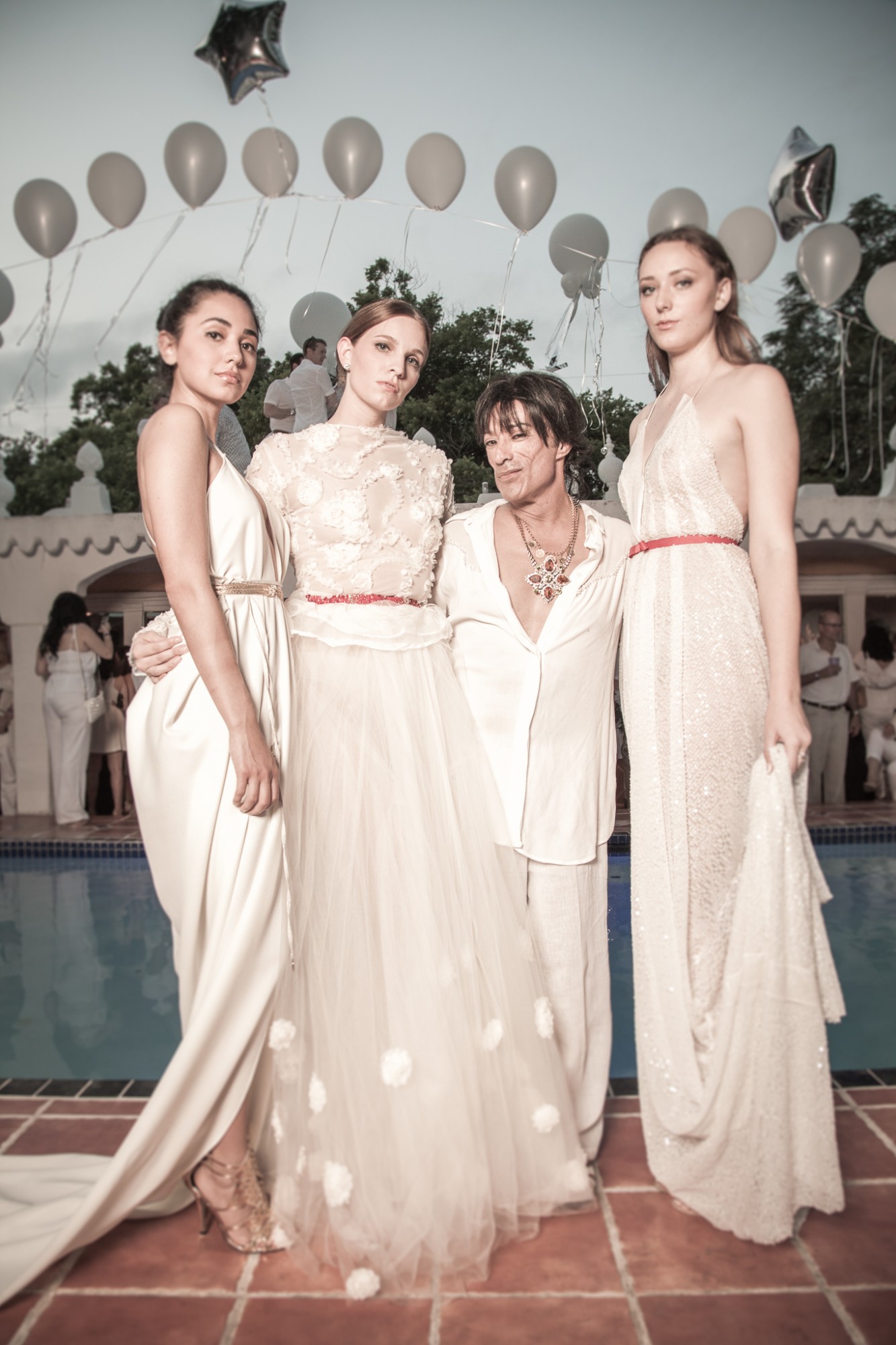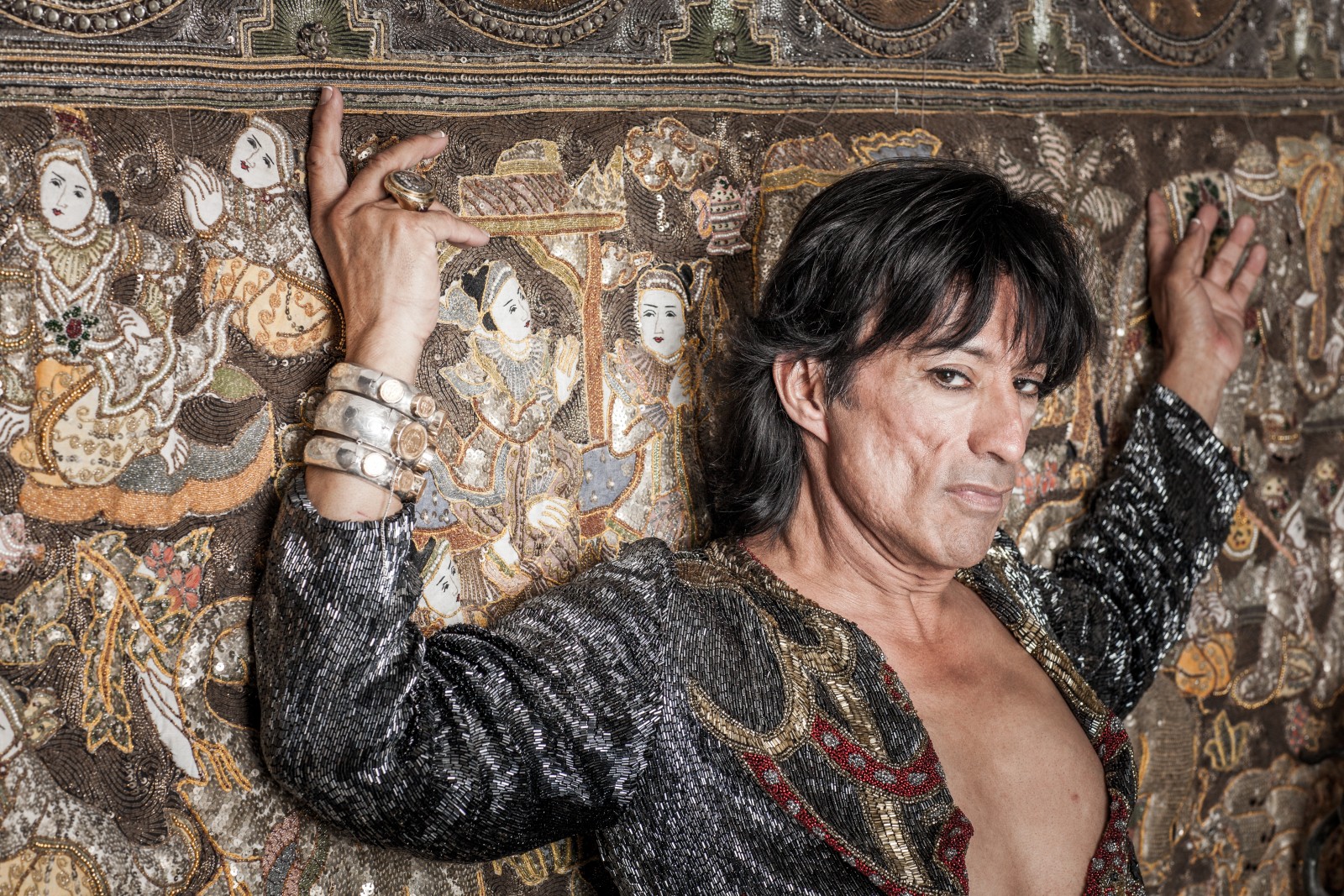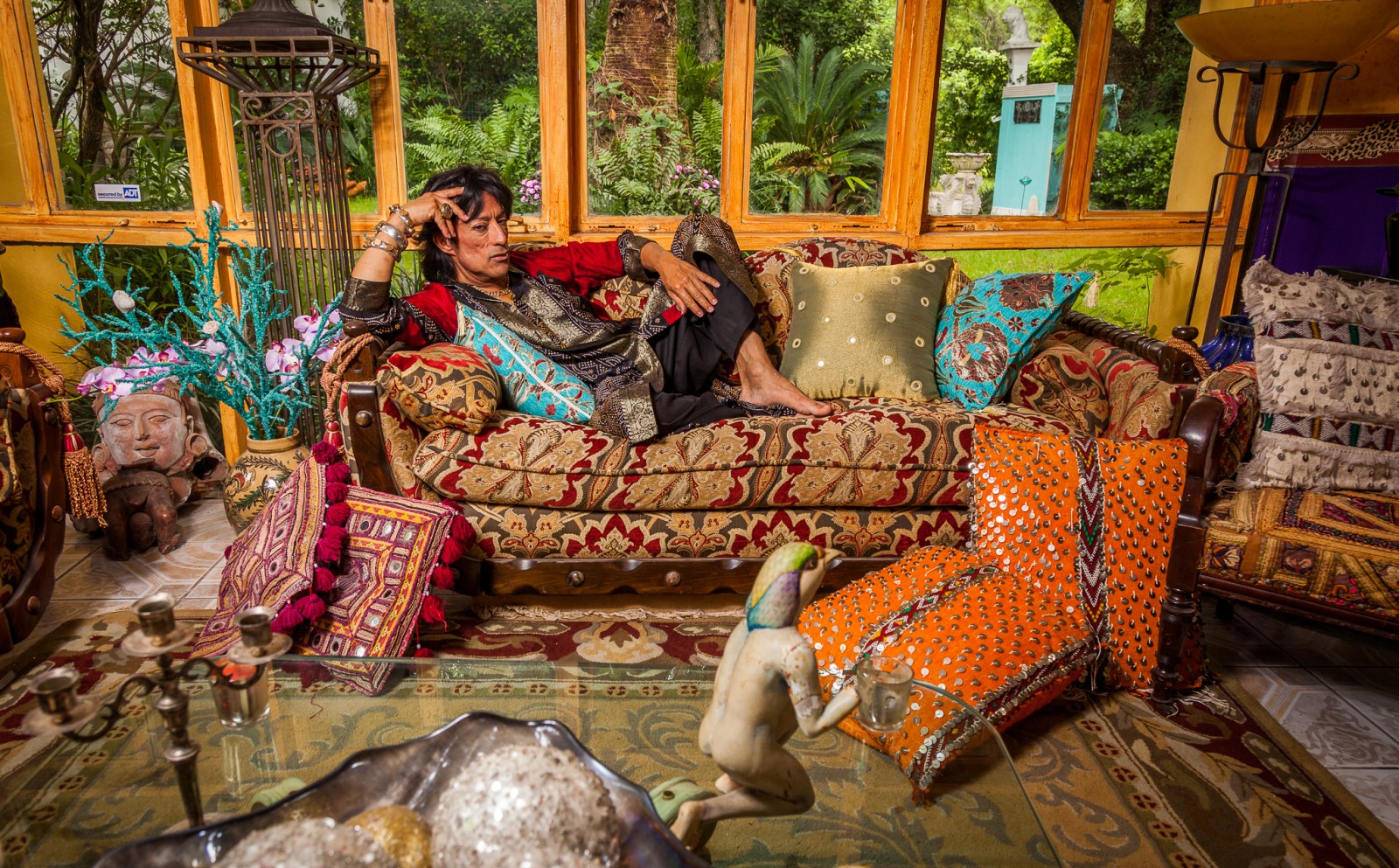Karlos Anzoategui’s Closet Is Wide Open
When you pass the whitewashed stucco walls, go through the gate on Queen Anne Court, and head into Villa Sol, Karlos Anzoategui’s work-and- life HQ, you leave earthly concerns behind. Like Gloria Swanson’s Sunset Boulevard manse, or, say, the Vatican, you’ve entered a self-contained world where, if the walls could talk, they’d speak of things that would outright kill your grandmother. Or maybe not — Karlos’ longtime clientele includes blue-blooded society ladies of a certain age. You can almost feel their Estée Lauder Youth Dew-scented phantoms adorning the graceful courtyard in white linen separates and big lunettes, admiring the romantic Mediterranean-meets-Moorish facades, or waving gaily through the wall of pool-facing windows.
But the premises are busy; workers are preparing for that Sunday’s annual White Party. It’s a glittering fundraiser for Family Endeavors, a local nonprofit that provides support and services to low-income families and veterans, particularly those with severe disabilities. Karlos and his co-host, Michelle Young, have spent months planning. There will be catering, several bars, umpteen elements of white decor, elaborate lighting, valet parking and a couture runway exhibition.
I scuttle past the workers and push through the heavy, grand, wooden doorway into a foyer where Mr. Anzoategui, Karlos-with- a-“K” himself, tends expertly to the long tresses of a beautiful young client. He is slender and deeply tanned, his jet-black hair smoothly coiffed with wispy bangs. He is gracious, smiling broadly. “Hello, honey!” he croons. It feels like there’s a musical number coming on — as if a row of tuxedoed dandies might prance in backwards single-file, canes touching top hats, onto the open parquet floor.
Photographer Marc Arevalo and his partner, fashion designer Leighton Whittington, confer nearby about the afternoon’s photo shoot.
Leighton tells me of having been a young boy at one of Karlos’ New Year’s Eve parties, and having grasped something of the naughty, the unashamed — a stage upon which his near-naked young body could shine. You learn things from Karlos.
After he finishes the young woman’s hair, Karlos glides through his domain and proposes settings for the shoot. He’s got numerous sexy little nooks on hand in the sprawling atelier-meets-Narnia space, and he shows off an arsenal of languid poses: He drapes his sylphlike frame over a tapestried love seat situated between twin decorative lamp posts, gazes up at the camera, freezes. “Bang!” he says, gliding over to lean against an ornate railing framed by glittering gold fabric. “Boom!” he says, cocking his head and tipping it against an outstretched arm.
Leighton and I follow him into a packed closet worthy of a Fiesta queen — the only closet, figuratively speaking, that Karlos has ever found himself in.
Karlos shows us a sparkling, 25-pound, white beaded jacket, bespoke blouses flurried with hand-sewn sequins, impossibly narrow leather trousers, a one-of-a-kind chunky gold bracelet he designed to show off a collection of Roman coins. I marvel, while Leighton briskly flips through the racks of shimmering slinkwear with practiced hands. He pulls out several options, among them a breathtaking sheer turquoise tunic enriched with gold brocade, and sweeps away to organize the first shots.
Karlos turns to me with his hands on his hips, and, with a theatrical sigh, says, “Well, I guess they want me to be Piss-elegant Glamour Bitch today.
“Piss-elegant” is one of the cornerstones of Karlos’ repartee. He got it from the OG queens back in his early hairdressing days, and it’s used to describe the rare and legendary, the eye-catching and unassailably fab, and imbue it with the acrid-sharp appraisal of the masters of resourceful, back-door chic. But, more than a compliment, it’s a creed — and a lineage.
White-stravaganza
Though the attendees’ attire is unfailingly white, as directed — “Not ecru, not peach!” Karlos instructed me when I asked about the dress code — the assembled guests are diverse. And not only in ethnicity and color, but along the gender spectrum, spanning the decades of age, and in various states of undress and intoxication. They swan in from the valet parking outside the compound, lounge on the rooftop terrace; hover like moths around the globes of outdoor light. They laugh loudly; their Champagne glasses and jewelry clink. Some wait in line inside to tinkle, while gossiping in stage whispers behind cupped hands.
I’ve arrived slightly late, and the party is beyond underway. The dance floors, of which there are several, are hopping. There’s been a wildly successful parade of Leighton W. Couture designs, and people are buzzing for this — and other — reasons. I delicately quiz some of the revelers. For most, it wasn’t their first time at the Villa Sol rodeo. They save the date every year. It’s an intensely happy, playfully naughty crowd. A lot of sparkly nalgas and glittered décolletage on display; a lot of handsy flirting. Two different men, one much younger and one much, much older than I, offer to make out with me. It occurs to me that, my professional demurrals aside, their chances are likely pretty good.
Well-heeled dowagers egg each other on to flirt with the passel of improbably gorgeous and very young men. They dance together, their hands in the air. The willowy young models there for the runway show giggle and sip Champagne, clamoring for Leighton’s attention, while dodging approaches by tipsy late-middle-aged husbands uncomfortable in white get-ups (some Western-themed, some Miami Beach-esque) that their wives picked out. Many of these wives are much younger, with even younger faces and the breasts of an 18-year-old Charo. Music is blaring, inside and out.
Karlos is nowhere to be found. Not because he’s left, but because he’s everywhere. “He’s outside somewhere, posing for photos.” “He was just right here, dancing.” “Honey, who knows? But, if you stay right here, you can catch him.”

Karlos Anzoatequi and models (dressed in Leighton W. Couture) photographed at the White Party by Marc Arevalo
I finally do, in the courtyard, near the pool, but not for long. He greets me, my companion and several other chatty well-wishers with kisses and embraces. Karlos is not sweating, but gleaming, slightly out of breath from dancing and joy. He’s wearing a fashionably oversized button-front dress shirt, open nearly to the waist, framing a golden, bejeweled statement necklace viewable from outer space, and the corner of one eye is adorned with a teardrop-shaped rhinestone. He kisses cheeks, poses for photos, exhorts everybody to stop standing around and DANCE! Get a margarita! Then he disappears in a dazzling whirlwind. As he does, I swear I can hear a harp glissando. My reverie is broken by a sudden ruckus, as a lady lost in mirth goes ass-over-teakettle backwards out of her patio seat, and several partygoers hasten to pick her up. She is unharmed, laughing sheepishly. A male friend, in soothing but spirited sympathy, cries in her defense, “Oh, these damn chairs!”
After the Ball
Karlos looks great, considering. He’s showered and clad in crisp workout gear, and stations us on a long, L-shaped sofa with crystal goblets of ice water.
“Quite a party last night, don’t you think?” he says, impishly.
His sisters, Linda and Belia, are on hand to help with the cleaning up. Several workers are outside, dismantling the lighting, the bars and the draperies. Occasionally, over the next hour and a half, he excuses himself to instruct somebody, or to find a bucket. His busy air of assured propriety is familiar now, having watched him navigate a photo shoot and a blowout glam soiree. What’s surprising are his thoughtful focus, his sense of mission, and his philosophical outlook. He reflects on his own life not as an exercise in self-adulation, but as the ongoing work of a man who was born to connect people, to push them to become themselves — only fancier — and to facilitate joy where little can be found.
“What does ‘Out In SA’ really mean?” he muses.
Nowadays, he observes, in this era of progress, LGBTQ people fight less stigma, and feel less ashamed and afraid than when he was young, which is wonderful — not that he grew up ashamed or afraid.
“I was out as a small child,” he says. Demonstrating his inborn flamboyance, profoundly social outlook and unalloyed nerve, Karlos threw his first party at the age of 5 by breaking into the storage shed of the neighborhood tiendita. He invited his friends and served soda pop, Fritos and attitude. When the owners heard the festivities and came out to investigate, “you’ve never seen 20 kids run so fast!”
When he was 7 or 8, he convinced his mother to drag her record player onto the front porch, so the whole neighborhood could watch him dance to her mambo records. The neighbors cheered. His mother was perplexed, but proud.
“Doesn’t that sound ‘out’ to you?” he asks.
In a note of sheer practicality that is the flip side to his expressive compulsion, he adds that he charged the neighbors a nickel each. He made three dollars. He was on his way.
Of course he encountered bullies in schools, he says. But he knew he could count on the timeless, sacred compact between gay boys and their female allies. “I would complain to my girlfriends, ‘Your boyfriend is being mean to me.’ And, of course, she’d put a stop to it immediately.”
After graduating from Fox Tech, then Audie and Joyce Beauty School, and receiving specialist training at Vidal Sassoon, Karlos began his ascent as a young hairstylist. His first two major purchases with his own money may seem frivolous, but reveal themselves as smart investments in a blooming psyche. One was a 40-gram gold bracelet, purchased at the Downtown Frost Brothers from the celebrated jewelry-counter goddess Lil Kaplan. The second, soon after he moved into his first apartment, was a white satin Jean Harlow sofa. Loath to risk marring the sofa, Karlos slept on the floor.
One of Karlos’ anchor territories was Wallace’s Beauty Salon, where among the mythic, fierce flaming queens who befriended and molded him was the legendary Vincent Flores. It was in this milieu that he came to adopt, refine and inhabit what he calls “The Ingredients of Out.”
“You must practice these at a very high level,” he orders: “Dress, Performance, Social Skills, Artistic Skill, Entertaining and Events, Wit, Culture, Design, Fearlessness, Defining Yourself and Creating a World.”
It may be instructive to take a look at Karlos’ ancestral provenance here; piss-elegance could well be heritable. In our back-and-forth text exchange post-interview, I asked him about his unusual last name. Was it Basque? Karlos’ reply should not have surprised me, but it did.
Yes, his grandfather’s father was born in Basque country, he answered, to the bloodline who founded the state of Anzoátegui in Venezuela. His grandfather then landed in Managua, Nicaragua, where he befriended Anastasio Somoza DeBayle in the waning days of his rule, and thence was put on a Sandinista death list. After his father and grandfather escaped, Mr. Anzoategui, Jr., took a post as a Staff Sergeant at Lackland Air Force Base. He then met Karlos’ mother, Celia, in “a famous after-hours nightclub called the Maracumbe.”
Mythic, romantic, and more than a little mysterious, Karlos could only have arisen from such an origin story as this.
He “came out socially” in the scenes surrounding the San Antonio Country and the Bonham Exchange at the peak of their cultural powers, where an LGBTQ revolution was assailed by SAPD and military police raids. “There were Iranian and Iraqi [military officers], in particular, who were very enthusiastic,” he smiles, “although, obviously, they had to be quite discreet.”
Meanwhile, his appointment book was filling with grande dames and “it” girls who came for a hairdo and stayed for the camaraderie. He began to invite them, and their husbands, to his parties, and was invited to their homes and gathering places in return, within the genteel, white cities within the city, whose self-defined elite are notorious for clannishness and closing ranks. Karlos strode from the San Antonio Country to the San Antonio Country Club, from the Bonham Exchange to the Argyle, without intimidation, with copious admiring allies, and under his own steam.
This is what it means to be “piss-elegant.”
So is this dictum: “When you have to, you out-dance the plague.”
The White Party, it should be noted, grew out of the Exotica Black Ball.
“I was one of the first out gay men who undertook the first of the AIDS fundraisers back in that dark, gloomy era.”
He staged the initial one at the Bonham Exchange at the beginning of the crisis. He had grown tired of feeling “helpless in my sadness,” the dread of “not if, but when,” watching his friends become consumed, the blank horror of no future, the all-out culture war and paranoia in the media, and the myriad unkindnesses that added insult to injury. The first two Exotica Black Balls donated proceeds to Casa de Care, the ad hoc, volunteer-run hospice founded by local bar owner Robert “Papa Bear” Edwards. This tiny humane enterprise has since grown into the San Antonio AIDS Foundation.
“It was the age of the Death House,” Karlos says. “I knew many men who went in and never came out.”
The fierce, young queen called upon his every Out-itude — the audacity of the 5-year-old party thrower, the ganas of the 7-year-old mambo marvel, the scrappy glamour of a young boy with a hard-earned Jean Harlow sofa — and he took over the Bonham with a roof-raising party of glittering honor, of cha-cha-heeled defiance.
“I dazzled the crowd with music and strobe lights,” he says, with increasing vehemence. “When death is all around, put on a leotard. Our flamboyance was not some frivolous distraction, it symbolized something: ‘You’re not a statistic.’”
Even then, Karlos knew he would survive. He was in a monogamous relationship with “a man of learning and magnificence,” which helped his chances. Some of it was luck. He’s still healthy, he says; he escaped the plague. We talk about friends who’ve been HIV-positive for 25 years or more, who have come to reckon with mortality not as imminent, but as eventual, who continue to hold steady, even to thrive. He knew this day of hope would come. As would the vaccine. He always had faith.
Over the years, the Exotica Black Ball evolved into the cheerier White Party, which was inspired in part by circuit parties in Miami. This year’s was the 12th.
Karlos is happy at the changes in his city, his country and the normalization of the LGBQT community.
Although, he muses, “Gaydom has become mainstream — gentrified, in a way — made more generic.”
There was a frisson of the truly subversive, back then. It was more dangerous, more stigmatized, and he doesn’t wish that on anybody. But the ferocity, the codes of conduct, the living art form of the classically trained queen, fragile and tough as a steel ballerina, exemplified an entire culture. The narrative was different, the stakes were higher, the outsider-dom had its own valor.
“We weren’t gay by proclamation. We were gay by design,” he says.
Who is your style idol? I ask. Who else embodies this same fierce glamour?
He hesitates not one instant. “Siegfried and Roy.” He is not kidding, although, when I laugh he says, “Listen, I think all of San Antonio knows I’m not a T-shirt and jeans kind of guy.”
But Karlos is eager to impart some loving life coaching, words of light to every and anybody struggling with being a person. Some Karlos axioms: Don’t be afraid of yourself. Be proud of who you are. Don’t butch up for some guy. Don’t allow yourself to be shamed. You can’t beat age, but you can fight it. It’s clever to be more tailored in your attire as you age, perhaps. Don’t collect people; gather them. Your life is acquiring ever more beautiful and fascinating layers, like Rome. Embrace it. Dance. Don’t stop at “accepted.” Go for piss-elegant.











